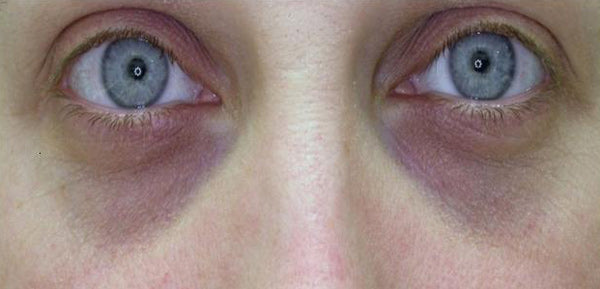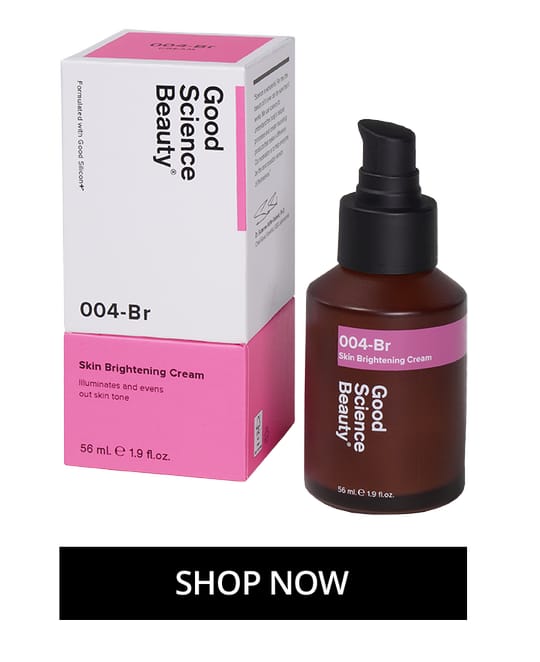What You Can Do About Dark Circles Under the Eyes
Nope, it's just not you... you're getting enough sleep, but the dark circles under your eyes elicit stares from strangers and make you look more tired and older than you are. You would do anything (well, almost) to get rid of them.
Anyone with dark circles knows how it feels.


You've probably googled 'how to get rid of dark circles' and found a hodgepodge of causes and treatments. This may have left you rather confused. Don't lose hope - here is a simple guide to the main causes (fyi lack of sleep is not the whole story) and treatments for dark eye circles. You'll be surprised that some solutions are just steps away from your couch.
What Are Dark Circles?
Dark Circles are literally just that.. when the skin beneath both eyes appears darkened. Some dark circles are accompanied by a bluish or purplish color caused by thin and translucent under-eye skin that you can see the veins beneath!
Dark Circles Aren't the Same as Eye Bags
Don't confuse eye bags with dark circles. They are two different things. Here is how you can tell them apart: dark circles are characterized by a darkening of the under-eye skin, while eye bags result in swelling around the eyes. Eye bag folks, we’ll catch you in another blog! In the meantime, you can check out this article on what to do about your eye bags.
Why Do You Have Dark Circles?
Many factors play a role in the appearance of dark circles, including genetic predisposition (thanks, Mom & Dad!👪), aging, allergies, as well as lifestyle triggers, like poor sleeping habits, exposure to UV light, or smoking. But contrary to popular belief, lack of sleep and fatigue are rarely the main cause of dark circles under your eyes; rather, they amplify their appearance. A 2015 study found that family history is the most significant factor contributing to the development of dark circles under the eyes.

Types of Dark Circles
Scientists distinguish between four types of dark eye circles and they all have different causes:
- Anatomical -Structural
- Vascular
- Pigmented
- Mixed
Let’s shed some light on them.
Structural/ Anatomical Dark Circles

Anatomical-Structural dark circles are mainly due to bone structure, the loss of under-eye fat with bony prominence, or a deep crease between the lower eyelid and upper cheek. If you see hollow contours and shadows under your eyes, you most likely have structural-type dark circles.
Vascular Dark Circles

Vascular dark circles are often accompanied by a bluish/ purplish undertone. If you already see a bluish discoloration of the lower eyelid and visible bluish veins in the under-eye area, bingo! The reason you see these unusual colors under your eyes is because of blood vessels and underlying muscle showing through the skin of the lower eyelid.
Vascular dark circles can be caused by natural aging. As we age we lose collagen and our skin becomes thinner, hence there is little camouflage, leading to the prominence of the underlying vascular network. Vascular-type dark circles are also present in those with allergy and sinus problems. Note that vascular dark circles present as a bluish, purplish discoloration due to visible blood vessels, but there is no change in the actual color of the skin.
Pigmented Dark Circles

Pigmented dark circles under the eyes are the most common form of dark circles and they can be caused by both genetics and lifestyle factors, such as sun exposure, smoking, and poor sleep.
Pigmented dark circles are usually a result of excess melanin under the eyes. When your body makes too much melanin (melanin is a large group of related molecules responsible for producing skin color/ pigment), your skin gets darker than the normal surrounding skin. So, if your eyes have a brown undertone to them (image above) then you most likely have pigmented-type dark circles.
Anyone can get dark circles, however, people with darker skin tones who have a high level of melanin in their skin are more likely to have pigmented dark circles.
Mixed-Type Dark Circles
Some people have a combination of the three above types. For example, many South Asians and Africans have a genetic predisposition to have very thin lower eyelid skin. This makes them more susceptible to the vascular type of dark circles because their veins show through the skin under their eyes. At the same time, the high melanin levels in their skin can lead to pigmented dark circles.
What Can You Do About Dark Circles?
So we now know that not all dark circles are the same. And this means that there is no one size fits all solution to getting rid of them. Treatment of dark circles depends on their cause.
What to Do About Anatomical Dark Circles
Anatomical-structural type dark circles often need treatments like facial fillers, radiofrequency skin tightening, and surgery (blepharoplasty). So if your dark circles have an anatomical cause, it’s best if you seek the advice of a dermatologist.
What to Do About Vascular Dark Circles
Vascular type dark circles require treatments aimed at improving the thickness of the skin. These may include skin booster dermal fillers, platelet-rich plasma (PRP), and fat transfer. Such treatments require advice and supervision by a dermatologist.
If you don’t like the idea of dermal fillers, you could try retinoids. Retinoids promote collagen synthesis and promote reorganization of collagen bundles to improve skin elasticity.
CAUTION >>> If you haven’t used retinoids before, go low and slow! Try just 1-2 nights a week for a couple of weeks to make sure your skin is happy with it. And to be on the safe side, we’d recommend consulting a dermatologist before you apply retinoids under the eyes as this is a very sensitive area.
What to Do About Pigmented Dark Circles
Unlike the anatomical-structural and vascular types of dark circles, dark circles caused by hyperpigmentation can be reduced effectively with cosmetic skin-brightening skincare. You just need to be patient because safe skin brightening takes time (if you come across any skin brightening products that promise you a quick fix, they probably do more harm than good to your skin).
Look out for these two vitamins in skin brightening products: Vitamin B3 (Niacinamide) and Vitamin C (Ascorbic Acid). They help decrease skin pigmentation over time, ultimately resulting in the lightening of the dark circles.
There are infinite ways that Niacinamide benefits the skin and dark under-eye circles are no exception. Niacinamide is a powerful antioxidant that helps reduce hyperpigmentation and helps brighten dark circles. It's safe for sensitive skin and poses a low risk of inflammation and irritation so you can apply it to the delicate thinner skin around the eyes without worry.
Vitamin C is famed for its role in collagen production by inhibiting the enzymes responsible for collagen degradation. It also provides lightening benefits through inhibition of tyrosinase. Tyrosinase, if you're wondering, is a key enzyme in melanin production. So Vitamin C helps prevent the overproduction and accumulation of melanin – the main cause of the pigmented form of dark circles under the eyes.
Our 004-Br Skin Brightening Cream contains both of these brightening superstars. But it also contains two other highly effective antioxidants: Melatonin and Glutathione.
Melatonin (yes, the sleeping aid!) can boost the efficacy of other antioxidants, such as Glutathione.
And similar to Vitamin C, Glutathione inhibits the production of melanin in the skin. Both Glutathione and the most potent form of Vitamin C – Ascorbic Acid – degrade easily but together they stabilize each other.
Our 004-Br Skin Brightening Cream also contains Dipeptide-2, a tiny peptide with only two amino acids (amino acids are the building block of proteins, and peptides are a few amino acids attached together), Valine and Tryptophan. Dipeptide-2 is known to combat dark and puffy under-eye circles and also improve lymphatic circulation. And because of its smaller size, it easily penetrates the skin's uppermost layers where it can assist with skin renewal and replenishment.
What to Do About Mixed Type Dark Circles
As you can imagine, treatment options for mixed type dark circles depend on their main causes. If you think you have the mixed type of dark circles or you are unsure, it’s best to consult a dermatologist.
Home Remedies for Dark Circles
If you are strapped for cash, there are also #some home remedies for treating the pigmented form of dark circles that will not cost you an arm and a leg.
But not all of those remedies work. Alexis Rochester from Chemistry Cachet (we are huge fans) has tested a large number of tips and tricks for dark circles and has narrowed them down to what actually works. Check out her blog post on Easy Home Remedies for Dark Circles that Actually Work.
And - you've still got makeup!
Makeup can help with all types of dark circles by masking and reflecting light. Read this step-by-step guide on how to cover dark circles with makeup like a pro.
Key Takeaways
- The skin on our lower eyelids is the thinnest in the entire body.
- Not all dark circles are the same. Scientists distinguish between pigmented, vascular, anatomical‐structural, and mixed types of dark circles.
- Contrary to popular belief, lack of sleep or fatigue are not the main cause of dark circles under the eyes. Rather they tend to amplify dark circles.
- Family history and genetics play a huge role in dark circles under the eyes, especially if they are persistent.
- Treatments depend on the type and causes of dark circles. If you have anatomical-structural or vascular dark circles, it's best to consult a dermatologist.
- For pigmented dark circles, try cosmetic skincare like our 004-Br Skin Brightening Cream.
SOURCES
Clinical analysis and classification of dark eye circles. Int J Dermatol. 2014




